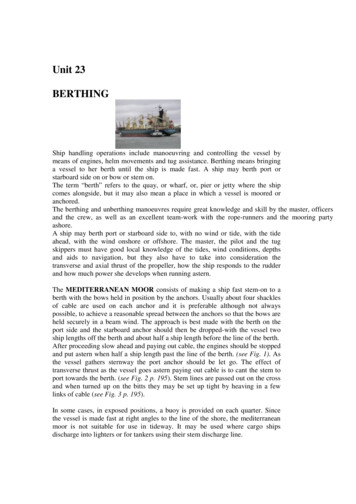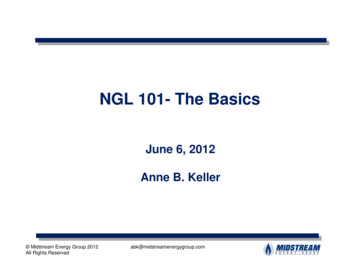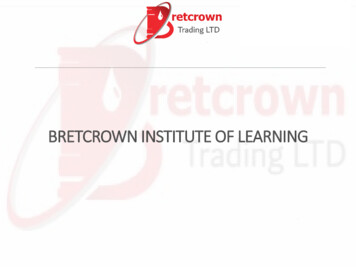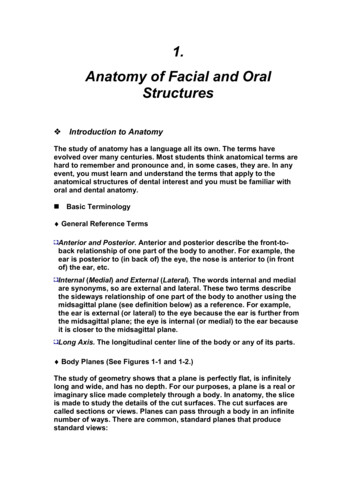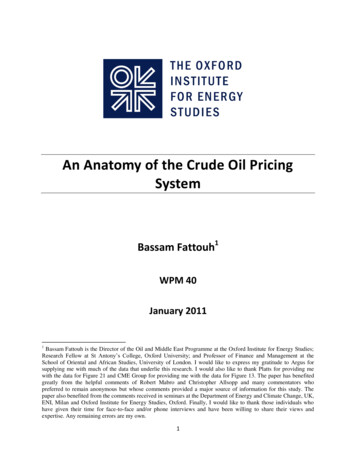
Transcription
An Anatomy of the Crude Oil PricingSystemBassam Fattouh1WPM 40January 20111Bassam Fattouh is the Director of the Oil and Middle East Programme at the Oxford Institute for Energy Studies;Research Fellow at St Antony‟s College, Oxford University; and Professor of Finance and Management at theSchool of Oriental and African Studies, University of London. I would like to express my gratitude to Argus forsupplying me with much of the data that underlie this research. I would also like to thank Platts for providing mewith the data for Figure 21 and CME Group for providing me with the data for Figure 13. The paper has benefitedgreatly from the helpful comments of Robert Mabro and Christopher Allsopp and many commentators whopreferred to remain anonymous but whose comments provided a major source of information for this study. Thepaper also benefited from the comments received in seminars at the Department of Energy and Climate Change, UK,ENI, Milan and Oxford Institute for Energy Studies, Oxford. Finally, I would like to thank those individuals whohave given their time for face-to-face and/or phone interviews and have been willing to share their views andexpertise. Any remaining errors are my own.1
The contents of this paper are the authors’ sole responsibility. They do notnecessarily represent the views of the Oxford Institute for Energy Studies or any of itsmembers.Copyright 2011Oxford Institute for Energy Studies(Registered Charity, No. 286084)This publication may be reproduced in part for educational or non-profit purposes without specialpermission from the copyright holder, provided acknowledgment of the source is made. No use of thispublication may be made for resale or for any other commercial purpose whatsoever without priorpermission in writing from the Oxford Institute for Energy Studies.ISBN978-1-907555-20-62
ContentsSummary Report . 61.Introduction . 112.Historical Background to the International Oil Pricing System . 14The Era of the Posted Price . 14The Pricing System Shaken but Not Broken . 14The Emergence of the OPEC Administered Pricing System . 15The Consolidation of the OPEC Administered Pricing System. 16The Genesis of the Crude Oil Market . 17The Collapse of the OPEC Administered Pricing System . 183.The Market-Related Oil Pricing System and Formulae Pricing . 20Spot Markets, Long-Term Contracts and Formula Pricing . 20Benchmarks in Formulae Pricing. 244.Oil Price Reporting Agencies and the Price Discovery Process . 305.The Brent Market and Its Layers . 36The Physical Base of North Sea . 37The Layers and Financial Instruments of the Brent Market . 39Data Issues . 39The Forward Brent . 40The Brent Futures Market . 43The Exchange for Physicals . 44The Dated Brent/BFOE. 45The Contract for Differences (CFDs) . 45OTC Derivatives . 48The Process of Oil Price Identification in the Brent Market . 506.The US Benchmarks . 52The Physical Base for US Benchmarks . 52The Layers and Financial Instruments of WTI . 55The Price Discovery Process in the US Market . 56WTI: The Broken Benchmark? . 587.The Dubai-Oman Market . 61The Physical Base of Dubai and Oman . 61The Financial Layers of Dubai. 623
The Price Discovery Process in the Dubai Market . 64Oman and its Financial Layers: A New Benchmark in the Making?. 668.Assessment and Evaluation. 70Physical Liquidity of Benchmarks . 70Shifts in Global Oil Demand Dynamics and Benchmarks . 71The Nature of Players and the Oil Price Formation Process . 73The Linkages between Physical Benchmarks and Financial Layers. 74Adjustments in Price Differentials versus Price Levels . 74Transparency and Accuracy of Information . 769.Conclusions . 78References . 81List of FiguresFigure 1: Price Differentials of Various Types of Saudi Arabia‟s Crude Oil to Asia in /Barrel . 21Figure 2: Differentials of Term Prices between Saudi Arabia Light and Iran Light Destined to Asia (FOB)(In US cents) . 23Figure 3: Difference in Term Prices for Various Crude Oil Grades to the US Gulf (Delivered) and Asia(FOB) . 24Figure 4: Price Differential between Dated Brent and BWAVE ( /Barrel) . 26Figure 5: Price Differential between WTI and ASCI ( /Barrel) (ASCI Price 0) . 26Figure 6: Brent Production by Company (cargoes per year), 2007 . 37Figure 7: Falling output of BFO . 38Figure 8: Trading Volume and Number of Participants in the 21-Day BFOE Market . 42Figure 9: Average Daily Volume and Open Interest of ICE Brent Futures Contract . 44Figure 10: Pricing basis of Dated Brent Deals (1986-1991); Percentage of Total Deals . 45Figure 11: Reported Trade on North Sea CFDs (b/d) . 46Figure 12: US PADDS . 52Figure 13: Monthly averages of volumes traded of the Light Sweet Crude Oil Futures Contract . 55Figure 14:Liquidity at Different Segments of the Futures Curve (October 19, 2010) . 56Figure 15: Spot Market Traded Volumes (b/d) (April 2009 Trade Month) . 57Figure 16: Spread between WTI 12-weeks Ahead and prompt WTI ( /Barrel) . 59Figure 17: WTI-BRENT Price Differential ( /Barrel). 60Figure 18: Dubai and Oman Crude Production Estimates (thousand barrels per day) . 62Figure 19: Spread Deals as a Percentage of Total Number of Dubai Deals . 63Figure 20: Oman-Dubai Spread ( /Barrel) . 64Figure 21: Dubai Partials Jan 2008 - Nov 2010 . 65Figure 22: daily Volume of Traded DME Oman Crude Oil Futures Contract . 67Figure 23: Volume and Open Interest of the October 2010 Futures Contracts (Traded During Month ofAugust). 684
Figure 24: OECD and Non-OECD Oil Demand Dynamics. 71Figure 25: Change in Oil Trade Flow Dynamics . 72Figure 26: The North Sea Dated differential to Ice Brent during the French Strike . 765
Summary ReportThe view that crude oil has acquired the characteristics of financial assets such as stocks or bonds hasgained wide acceptance among many observers. However, the nature of „financialisation‟ and itsimplications are not yet clear. Discussions and analyses of „financialisation‟ of oil markets have partlybeen subsumed within analyses of the relation between finance and commodity indices which includecrude oil. The elements that have attracted most attention have been outcomes: correlations betweenlevels, returns, and volatility of commodity and financial indices. However, a full understanding of thedegree of interaction between oil and finance requires, in addition, an analysis of interactions, causationsand processes such as the investment and trading strategies of distinct types of financial participants; thefinancing mechanisms and the degree of leverage supporting those strategies; the structure of oilderivatives markets; and most importantly the mechanisms that link the financial and physical layers ofthe oil market.Unlike a pure financial asset, the crude oil market also has a „physical‟ dimension that should anchorprices in oil market fundamentals: crude oil is consumed, stored and widely traded with millions ofbarrels being bought and sold every day at prices agreed by transacting parties. Thus, in principle, pricesin the futures market through the process of arbitrage should eventually converge to the so-called „spot‟prices in the physical markets. The argument then goes that since physical trades are transacted at spotprices, these prices should reflect existing supply-demand conditions.In the oil market, however, the story is more complex. The „current‟ market fundamentals are neverknown with certainty. The flow of data about oil market fundamentals is not instantaneous and is oftensubject to major revisions which make the most recent available data highly unreliable. Furthermore,though many oil prices are observed on screens and reported through a variety of channels, it is importantto explain what these different prices refer to. Thus, although the futures price often converges to a „spot‟price, one should aim to analyse the process of convergence and understand what the „spot‟ price in thecontext of the oil market really means.Unfortunately, little attention has been devoted to such issues and the processes of price discovery in oilmarkets and the drivers of oil prices in the short-run remain under-researched. While this topic is linked tothe current debate on the role of speculation versus fundamentals in the determination of the oil price, itgoes beyond the existing debates which have recently dominated policy agendas. This report offers afresh and deeper perspective on the current debate by identifying the various layers relevant to the priceformation process and by examining and analysing the links between the financial and physical layers inthe oil market, which lie at the heart of the current international oil pricing system.The adoption of the market-related pricing system by many oil exporters in 1986-1988 opened a newchapter in the history of oil price formation. It represented a shift from a system in which prices were firstadministered by the large multinational oil companies in the 1950s and 1960s and then by OPEC for theperiod 1973-1988 to a system in which prices are set by „markets‟. First adopted by the Mexican nationaloil company PEMEX in 1986, the market-related pricing system received wide acceptance among mostoil-exporting countries. By 1988, it became and still is the main method for pricing crude oil ininternational trade after a short experimentation with a products-related pricing system in the shape of thenetback pricing regime in the period 1986-1987. The oil market was ready for such a transition. The endof the concession system and the waves of nationalisation which disrupted oil supplies to multinational oilcompanies established the basis of arm‟s-length deals and exchange outside the vertically andhorizontally integrated multinational companies. The emergence of many suppliers outside OPEC andmany buyers further increased the prevalence of such arm‟s-length deals. This led to the development of acomplex structure of interlinked oil markets which consist of spot and also physical forwards, futures,options and other derivative markets referred to as paper markets. Technological innovations which madeelectronic trading possible revolutionised these markets by allowing 24-hour trading from any place in the6
world. It also opened access to a wider set of market participants and allowed the development of a largenumber of trading instruments both on regulated exchanges and over the counter.Physical delivery of crude oil is organised either through the spot (cash) market or through long-termcontracts. The spot market is used by transacting parties to buy and sell crude oil not covered by longterm contractual arrangements and applies often to one-off transactions. Given the logistics oftransporting oil, spot cargoes for immediate delivery are rare. Instead, there is an important element offorwardness in spot transactions. The parties can either agree on the price at the time of agreement, inwhich case the sport transaction becomes closer to a „forward‟ contract. More often though, transactingparties link the pricing of an oil cargo to the time of loading.Long-term contracts are negotiated bilaterally between buyers and sellers for the delivery of a series of oilshipments over a specified period of time, usually one or two years. They specify among other things, thevolumes of crude oil to be delivered, the delivery schedule, the actions to be taken in case of default, andabove all the method that should be used in calculating the price of an oil shipment. Price agreements areusually concluded on the method of formula pricing which links the price of a cargo in long-termcontracts to a market (spot) price. Formula pricing has become the basis of the oil pricing system.Formula pricing has two main advantages. Crude oil is not a homogenous commodity. There are varioustypes of internationally traded crude oil with different qualities and characteristics which have a bearingon refining yields. Thus, different crudes fetch different prices. Given the large variety of crude oils, theprice of a particular type is usually set at a discount or at a premium to marker or reference prices, oftenreferred to as benchmarks. The differentials are adjusted periodically to reflect differences in the qualityof crudes as well as the relative demand and supply of the various types of crudes. Another advantage offormula pricing is that it increases pricing flexibility. When there is a lag between the date at which acargo is bought and the date of arrival at its destination, there is a price risk. Transacting parties usuallyshare this risk through the pricing formula. Agreements are often made for the date of pricing to occuraround the delivery date.At the heart of formulae pricing is the identification of the price of key „physical‟ benchmarks, such asWest Texas Intermediate (WTI), Dated Brent and Dubai-Oman. The benchmark crudes are a centralfeature of the oil pricing system and are used by oil companies and traders to price cargoes under longterm contracts or in spot market transactions; by futures exchanges for the settlement of their financialcontracts; by banks and companies for the settlement of derivative instruments such as swap contracts;and by governments for taxation purposes.Few features of these physical benchmarks stand out. Markets with relatively low volumes of productionsuch as WTI, Brent, and Dubai set the price for markets with higher volumes of production elsewhere inthe world. Despite the high level of volumes of production in the Gulf, these markets remain illiquid:there is limited spot trading in these markets, no forwards or swaps (apart from Dubai), and no liquidfutures market since crude export contracts include destination and resale restrictions which limit tradingoptions. While the volume of production is not a sufficient condition for the emergence of a benchmark, itis a necessary condition for a benchmark‟s success. As markets become thinner and thinner, the pricediscovery process becomes more difficult. Oil price reporting agencies cannot observe enough genuinearms-length deals. Furthermore, in thin markets, the danger of squeezes and distortions increases and as aresult prices could then become less informative and more volatile thereby distorting consumption andproduction decisions. So far the low and continuous decline in the physical base of existing benchmarkshas been counteracted by including additional crude streams in an assessed benchmark. This had theeffect of reducing the chance of squeezes as these alternative crudes could be used for delivery against thecontract. Although such short-term solutions have been successful in alleviating the problem of squeezes,observers should not be distracted from some key questions: What are the conditions necessary for theemergence of successful benchmarks in the most physically liquid market? Would a shift to assessing7
price in these markets improve the price discovery process? Such key questions remain heavily underresearched in the energy literature and do not feature in the consumer-producer dialogue.The emergence of the non-OECD as the main source of growth in global oil demand will only increasethe importance of such questions. One of the most important shifts in oil market dynamics in recent yearshas been the shift in oil trade flows to Asia: this may have long-term implications on pricing benchmarks.Questions are already being raised whether Dubai still constitutes an appropriate benchmark for pricingcrude oil exports to Asia given its thin physical base or whether new benchmarks are needed to reflectmore accurately the recent shift in trade flows and the rise in prominence of the Asian consumer.Unlike the futures market where prices are observable in real time, the reported prices of physicalbenchmarks are „identified‟ or „assessed‟ prices. Assessments are needed in opaque markets such as crudeoil where physical transactions concluded between parties cannot be directly observed by outsiders.Assessments are also needed in illiquid markets where there are not enough representative deals or whereno transactions are concluded. These assessments are carried out by oil pricing reporting agencies(PRAs), the two most important of which are Platts and Argus. While PRAs have been an integral part ofthe oil pricing system, especially since the shift to the market-related pricing system in 1986, their rolehas recently been attracting considerable attention. In the G20 summit in Korea in November 2010, theG20 leaders called for a more detailed analysis on „how the oil spot market prices are assessed by oilprice reporting agencies and how this affects the transparency and functioning of oil markets‟. In its latestreport in November 2010, IOSCO points that „the core concern with respect to price reporting agencies isthe extent to which the reported data accurately reflects the cash market in question‟. PRAs do not onlyact as „a mirror to the trade‟. In their attempt to identify the price that reflects accurately the market valueof an oil barrel, PRAs enter into the decision-making territory which can influence market structure.What they choose to do is influenced by market participants and market structure while they in turninfluence the trading strategies of the various participants. New markets and contracts may emerge tohedge the risks arising from some PRAs‟ decisions. To evaluate the role of PRAs in the oil market, it isimportant to look at three inter-related dimensions: the methodology used in indentifying the oil price; theaccuracy of price assessments; and the internal measures that PRAs implement to protect the integrity andensure an efficient assessment process. There is a fundamental difference in the methodology and in thephilosophy underlying the price assessment process between the various PRAs. As a result, differentagencies may produce different prices for the same benchmark. This raises the issue of which methodproduces a more accurate price assessment. Given that assessed prices underlie long-term contracts, spottransactions and derivatives instruments, even small differences in price assessments between PRAs haveimportant implications on exporters‟ revenues and financial flows between parties in financial contracts.In the last two decades or so, many financial layers (paper markets) have emerged around crude oilbenchmarks. They include the forward market (in Brent and Dubai), swaps, futures, and options. Some ofthe instruments such as futures and options are traded on regulated exchanges such as ICE and CMEGroup, while other instruments, such as swaps, options and forward contracts, are traded bilaterally overthe counter (OTC). Nevertheless, these financial layers are highly interlinked through the process ofarbitrage and the development of instruments that links the various layers together. Over the years, thesemarkets have grown in terms of size, liquidity, sophistication and have attracted a diverse set of playersboth physical and financial. These markets have become central for market participants wishing to hedgetheir risk and to bet on oil price movements. Equally important, these financial layers have becomecentral to the oil price identification process.At the early stages of the current pricing system, linking prices to benchmarks in formulae pricingprovided producers and consumers with a sense of comfort that the price is grounded in the physicaldimension of the market. This implicitly assumes that the process of identifying the price of benchmarkscan be isolated from financial layers. However, this is far from reality. The analysis in this report showsthat the different layers of the oil market form a complex web of links, all of which play a role in the pricediscovery process. The information derived from financial layers is essential for identifying the price8
level of the benchmark. In the Brent market, the oil price in the forward market is sometimes priced as adifferential to the price of the Brent futures contract using the Exchange for Physicals (EFP) market. Theprice of Dated Brent or North Sea Dated in turn is priced as a differential to the forward market throughthe market of Contract for Differences (CFDs), another swaps market. Given the limited number ofphysical transactions and hence the limited amount of deals that can be observed by oil reportingagencies, the value of Dubai, the main benchmark used for pricing crude oil exports to East Asia, is oftenassessed by using the value of differentials in the very liquid OTC Dubai/Brent swaps market. Thus, onecould argue that without these financial layers it would not be possible to „discover‟ or „identify‟ oilprices in the current oil pricing system. In effect, crude oil prices are jointly or co-determined in bothlayers, depending on differences in timing, location and quality of crude oil.Since physical benchmarks constitute the pricing basis of the large majority of physical transactions,some observers claim that derivatives instruments such as futures, forwards, options and swaps derivetheir value from the price of these physical benchmarks, i.e., the prices of these physical benchmarksdrive the prices in paper markets. However, this is a gross over-simplification and does not accuratelyreflect the process of crude oil price formation. The issue of whether the paper market drives the physicalor the other way around is difficult to construct theoretically and test empirically and requires furtherresearch.The report also calls for broadening the empirical research to include the trading strategies of physicalplayers. In recent years, the futures markets have attracted a wide range of financial players includingswap dealers, pension funds, hedge funds, index investors, technical traders, and high net worthindividuals. There are concerns that these financial players and their trading strategies could move the oilprice away from the „true‟ underlying fundamentals. The fact remains however that the participants inmany of the OTC markets such as forward markets and CFDs which are central to the price discoveryprocess are mainly „physical‟ and include entities such as refineries, oil companies, downstreamconsumers, physical traders, and market makers. Financial players such as pension funds and indexinvestors have limited presence in many of these markets. Thus, any analysis limited to non-commercialparticipants in the futures market and their role in the oil price formation process is incomplete and alsopotentially misleading.The report also makes the distinction between trade in price differentials and trade in price levels. Itshows that trades in the levels of the oil price rarely take place in the layers surrounding the physicalbenchmarks. We postulate that the price level of the main crude oil benchmarks is set in the futuresmarkets; the financial layers such as swaps and forwards set the price differentials depending on quality,location and timing. These differentials are then used by oil reporting agencies to identify the price levelof a physical benchmark. If the price in the futures market becomes detached from the underlyingbenchmark, the differentials adjust to correct for this divergence through a web of highly interlinked andefficient markets. Thus, our analysis reveals that the level of the crude oil price, which consumers,producers and their governments are most concerned with, is not the most relevant feature in the currentpricing system. Instead, the identification of price differentials and the adjustments in these differentialsin the various layers underlie the basis of the current crude oil pricing system. By trading differentials,market participants limit their exposure to the risks of time, location grade and volume. Unfortunately,this fact has received little attention and the issue of whether price differentials between different marketsshowed strong signs of adjustment in the 2008-2009 price cycle has not yet received due attention in theempirical literature.But this leaves us with a fundamental question: what determines the price level of a certain benchmark inthe first place? The pricing system reflects how the oil market functions: if price levels are set in thefutures market and if m
1 An Anatomy of the Crude Oil Pricing System. Bassam Fattouh1 WPM 40 . January 2011 . 1 Bassam Fattouh is the Director of the Oil and Middle East Programme at the Oxford Institute for Energy Studies; Research Fellow at St Antony‟s College, Oxford U
